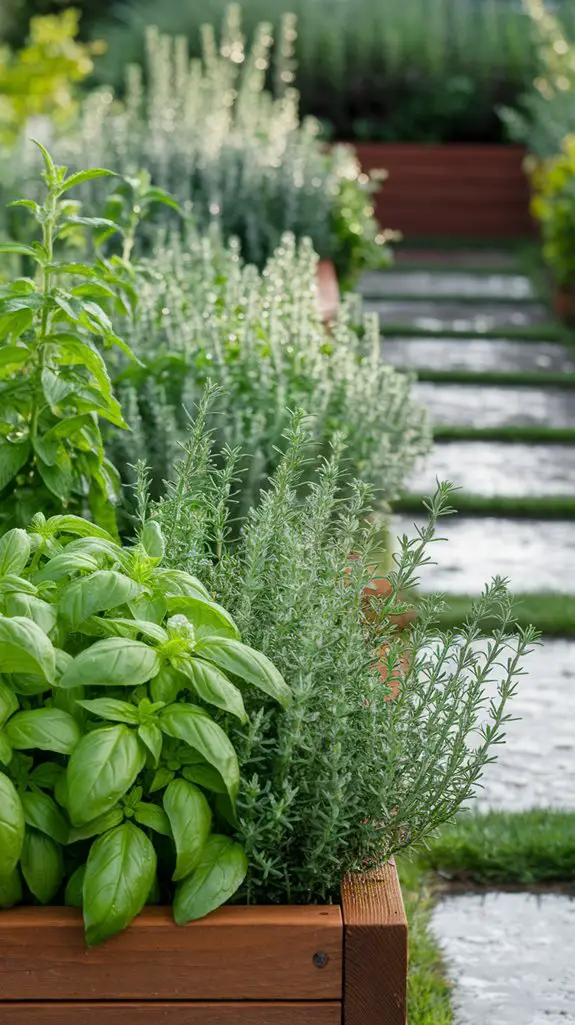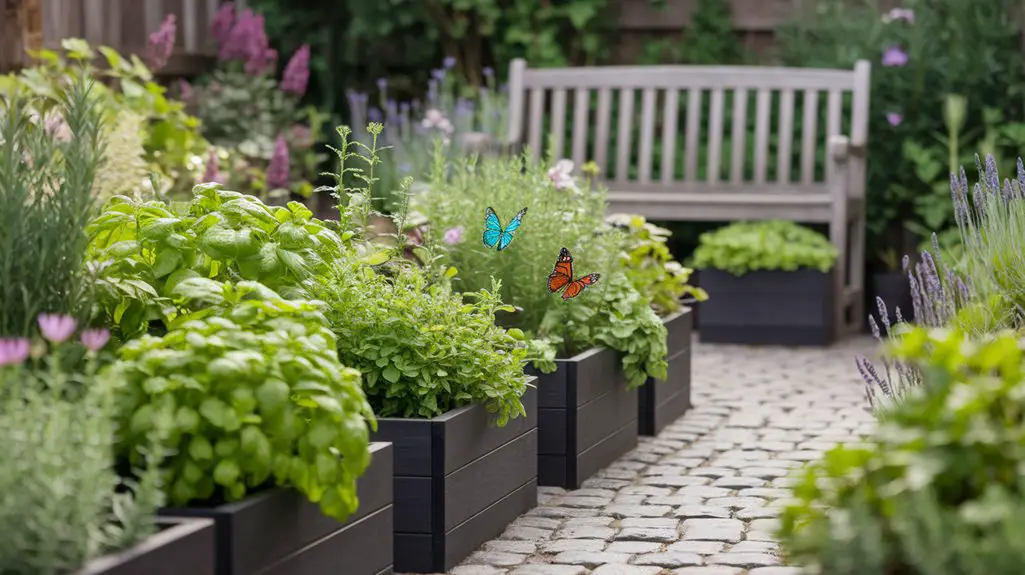You'll transform your garden space with strategic raised herb beds that offer both practical advantages and visual appeal. These elevated growing zones provide superior drainage, customizable soil composition, and easier maintenance without constant bending. By positioning your herbs at the perfect height and location, you're creating microclimates where Mediterranean varieties thrive alongside moisture-loving plants. The combination of fragrance, texture, and color can turn an ordinary yard into an aromatic sanctuary that enhances your culinary adventures.
Why Raised Beds Are Perfect for Growing Herbs
Raised beds offer five distinct advantages that make them ideal for herb cultivation.
First, they provide superior drainage—essential for Mediterranean herbs like rosemary and thyme that detest wet feet.
Second, the elevated soil warms faster in spring, extending your growing season by several weeks on both ends of the calendar.
Third, you'll gain precise control over soil composition, allowing you to create the perfect growing medium for each herb's specific pH and nutrient requirements.
Fourth, the defined boundaries prevent invasive herbs such as mint from colonizing your entire garden.
Finally, the ergonomic height (typically 10-24 inches) reduces back strain during planting, harvesting, and maintenance—particularly beneficial when you're frequently snipping fresh herbs for culinary use. Additionally, raised beds can enhance soil health by promoting beneficial microbial activity and reducing soil compaction.
Choosing the Best Location for Your Herb Garden

When selecting a location for your raised herb garden, prioritize areas that receive 6-8 hours of direct sunlight daily, as most culinary herbs evolved in Mediterranean climates and require abundant light for ideal oil production. Consider proximity to your kitchen for convenient harvesting during meal preparation. Assess drainage patterns in potential locations, avoiding low-lying areas where water collects. Your site should have adequate airflow to prevent fungal issues while offering protection from strong winds that can damage tender stems and strip volatile oils from aromatic leaves. If you're growing both sun-loving herbs (rosemary, basil, thyme) and shade-tolerant varieties (mint, parsley), position your beds to accommodate these varying requirements, perhaps using taller plants or structures to create microclimates within your garden system. Additionally, raised garden beds can improve soil quality and drainage, which is essential for healthy herb growth.
Selecting Materials for Long-Lasting Raised Beds

Three primary considerations should guide your material selection for raised herb beds: durability, safety, and compatibility with your garden's aesthetic.
Cedar and redwood offer natural rot resistance without chemical treatments, lasting 10-15 years. Avoid pressure-treated lumber containing harmful compounds that can leach into soil and herbs.
Alternative materials include composite lumber (recycled plastic/wood fiber blend), which won't splinter or rot but costs more initially.
Galvanized steel provides excellent longevity (20+ years) with modern appeal, though it heats up in direct sunlight.
Concrete blocks create sturdy, permanent structures with excellent heat retention for Mediterranean herbs like rosemary and thyme.
Match your material choice to your climate conditions—wood performs poorly in humid regions, while metal may overheat in hot zones. Additionally, consider organic gardening practices that focus on enhancing soil health and promoting biodiversity in your raised beds.
Essential Herbs That Thrive in Raised Garden Beds

The ideal raised bed environment creates perfect growing conditions for numerous culinary and medicinal herbs that might struggle in conventional garden plots. Mediterranean natives like rosemary, thyme, and sage flourish in the well-drained soil structure, while mint family members including oregano and basil benefit from controlled growing spaces that prevent aggressive spreading.
Plant perennial herbs like chives and lavender along the northern edge to avoid shading smaller varieties. Cilantro, dill, and parsley—which prefer cooler conditions—thrive when positioned where they'll receive morning sun but afternoon shade.
Chamomile and lemon balm perform exceptionally well in raised settings, requiring minimal intervention once established. For best yields, group herbs with similar watering needs together—drought-tolerant rosemary shouldn't share space with moisture-loving basil or mint. Additionally, incorporating edible landscaping techniques can enhance both the aesthetic and functional aspects of your herb garden.
Design Ideas to Maximize Your Herb Garden Space

Strategic planning transforms limited raised bed space into a productive herb garden that satisfies both culinary needs and aesthetic desires. Implement vertical gardening using trellises or wall-mounted planters for climbing herbs like nasturtium. Reserve bed perimeters for aggressive spreaders such as mint and oregano. Additionally, incorporating creative raised garden bed ideas can help enhance both functionality and visual appeal in your herb garden.
Seasonal Maintenance Tips for Flourishing Herb Beds
Once your herb garden design is implemented, maintaining its essence throughout the changing seasons becomes your next focus. Cultivate a proactive maintenance schedule aligned with nature's rhythm to guarantee robust growth and flavor retention. Additionally, incorporating a variety of herbs can attract beneficial insects that help with pollination and pest control.
| Season | Primary Tasks | Key Considerations |
|---|---|---|
| Spring | Prune, divide, fertilize | Apply compost tea after last frost |
| Summer | Harvest, water deeply | Morning irrigation to prevent fungal issues |
| Fall/Winter | Mulch, selective harvesting | Protect perennials with straw layers |
Don't neglect pH monitoring—most culinary herbs prefer slightly alkaline conditions (6.5-7.0). Implement targeted pruning of flowering herbs to extend vegetative growth and essential oil production. When temperatures fluctuate dramatically, consider temporary row covers to stabilize microclimate conditions within your raised beds.
Companion Planting Strategies for Healthier Herbs
Maximizing your herb garden's potential requires thoughtful companion planting—strategic arrangement of plants that symbiotically enhance growth, deter pests, and improve flavor profiles.
Pair basil with tomatoes; the former deters flies and mosquitoes while improving tomato flavor. Plant rosemary alongside sage, cabbage, and carrots to repel cabbage moths and carrot flies.
Avoid placing fennel near coriander or dill, as these species compete aggressively for resources. Instead, position chamomile near mint to boost essential oil production.
Thyme serves as an excellent border plant, deterring cabbage worms while attracting beneficial pollinators.
For pest management, intersperse marigolds throughout your herb bed—their root exudates discourage nematodes and soil pathogens. Incorporating companion planting techniques can further optimize your garden's ecosystem.
Remember to group herbs with similar water and sunlight requirements to streamline maintenance and conserve resources.
Conclusion
As you nurture your raised bed herb garden, you'll notice how the cascading thyme coincidentally frames the sturdy rosemary, creating nature's perfect symmetry. You're not just growing plants; you're orchestrating a microecosystem that'll reward you year-round. With proper drainage, strategic companion planting, and seasonal maintenance, your elevated herb haven becomes both a culinary resource and an aromatic retreat—transforming your backyard into living, functional art.




